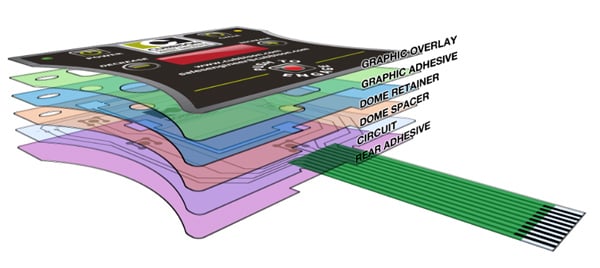Why Membrane Changes Are Necessary for Long Lasting Control Equipment
Membrane buttons play a crucial duty in making certain the longevity and reliability of control systems across numerous sectors. As we explore the diverse benefits of membrane layer switches, it ends up being apparent that their importance goes beyond plain functionality, influencing customer experience and functional effectiveness.
Overview of Membrane Switches
Membrane layer switches are functional and dependable elements frequently utilized in different electronic control systems. These switches consist of several layers, including a graphic overlay, a spacer layer, and a published circuit layer. The graphic overlay gives both practical and visual design, while the spacer layer ensures that the switches are turned on just when pressed. The published circuit layer consists of conductive traces that complete an electrical circuit when the membrane layer is pushed, making it possible for the tool to react to user inputs.
Membrane buttons are frequently favored in applications requiring a compact and lightweight style, making them optimal for portable tools, medical equipment, and commercial machinery. They can be tailored to fulfill particular customer needs and can include various attributes such as backlighting, tactile feedback, and multiple shades. Membrane switches are resistant to dust, moisture, and pollutants, making them ideal for settings where longevity is vital.
Benefits of Sturdiness
In many applications, the durability of membrane changes offers substantial advantages that improve their overall efficiency and dependability. These buttons are developed to withstand harsh settings, making them suitable for use sought after conditions such as high humidity, extreme temperatures, and direct exposure to chemicals. Their durable building and construction helps to avoid damages from physical effect, making certain lasting functionality and decreasing the need for regular replacements.
Furthermore, membrane switches are resistant to deterioration, which is essential in applications where regular interaction happens. This longevity translates to decrease maintenance prices, as organizations take advantage of decreased downtime and less solution interruptions. In addition, the encapsulated design of membrane changes protects interior components from dirt and dampness access, further adding to their lifespan.
An additional advantage is their ability to keep regular performance with time. With a high tolerance for mechanical tension, these switches protect their tactile responses and electrical honesty, ensuring individual contentment. Inevitably, the durability of membrane layer switches not only boosts operational efficiency however additionally promotes confidence in their reliability, making them a favored option for control systems across various sectors.
Applications in Various Industries
Durable control systems using membrane layer switches find substantial applications throughout a variety of industries, each profiting from the unique qualities these buttons supply. In the medical field, membrane layer buttons are vital for devices such as individual displays and diagnostic equipment, where reliability and ease of cleaning are critical. Their resistance to dampness and pollutants guarantees they keep capability in clean and sterile environments.
The automotive industry leverages membrane switches for control panel controls and infomercial systems, where they provide sleek, inconspicuous interfaces that boost customer experience. These switches are likewise designed to hold up against rough problems, consisting of exposure to severe temperatures and vibrations.
In commercial setups, membrane layer buttons are frequently made use of in equipment control panels, supplying responsive comments and durability essential for high-usage applications. Their capacity to stand up to chemicals makes them ideal for making environments where spills and impurities are frequent.

Customer electronics, such as kitchen area home appliances and push-button controls, additionally utilize membrane switches for their convenience and cost-effectiveness. In general, the versatility and robust nature of membrane switches over make them indispensable across various industries, ensuring effective procedure and longevity in control systems.
Layout and Visual Allure
While functionality is paramount, the layout and visual charm of control systems geared up with membrane buttons play a critical function in user interaction and general experience (membrane switch). The aesthetic design of these buttons websites can considerably affect user understanding and interaction. A well-designed membrane button boosts the beauty of the gadget, making it much more attractive to customers and fostering a link in between the customer and the item
Membrane layer changes offer a lot of flexibility Get More Information in style, allowing makers to customize graphics, colors, and appearances to straighten with brand name identity and product aesthetic appeals. Using dynamic colors and distinct patterns can attract attention, while responsive comments can reinforce the user's interaction with the device. In addition, the ability to integrate LED indications and backlighting right into the membrane layer button design gives both useful and visual benefits, improving exposure and usability in various atmospheres.

Enhancing Individual Experience

In addition, membrane buttons can be customized to incorporate visual user interfaces, improving usability by providing info in a clear and intuitive manner (membrane switch). This modification can include icons, tags, and shade coding that overview customers through complicated performances easily. In addition, their adaptability permits assimilation in various environments, guaranteeing constant performance whether in industrial machinery or customer electronics
The resilience of membrane switches additionally plays a vital duty in customer experience. By standing up to rough problems and expanded usage, these switches decrease the chance of system failings, therefore advertising dependability and user confidence. Inevitably, the calculated use of membrane changes not only boosts capability however additionally considerably enriches user interaction with control systems, making them an indispensable element in modern-day design.
Conclusion
